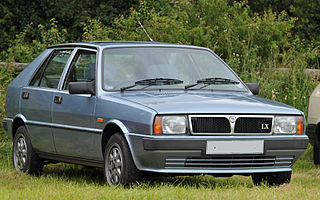
The Lancia Delta is a small family car produced by Italian automobile manufacturer Lancia in three generations. The first generation (1979-1994) debuted at the 1979 Frankfurt Motor Show, the second generation (1993-1999) debuted at the 1993 Geneva Motor Show, and the third generation (2008-2014) debuted at 2008 Geneva Motor Show.

The Lancia Stratos HF, known as Lancia Stratos, is a rear mid-engined sports car designed for rallying, made by Italian car manufacturer Lancia. It was a highly successful rally car, winning the World Rally Championship in 1974, 1975 and 1976; and race car winning 1974 Targa Florio, five times the Tour de France Automobile and three editions of Giro d'Italia automobilistico.

The Lancia Aurelia is a car produced by Italian manufacturer Lancia from 1950 to the summer of 1958. It is noted for using one of the first series-production V6 engines. Several body styles were offered: 4-door saloon, 2-door GT coupé (B20), 2-door spider/convertible (B24), and a chassis to be custom bodied by external coachbuilders.

The Lancia Fulvia is an automobile produced by Lancia between 1963 and 1976. Named after Via Fulvia, the Roman road leading from Tortona to Turin, it was introduced at the Geneva Motor Show in 1963 and manufactured in three variants: Berlina 4-door saloon, 2-door Coupé, and Sport, an alternative fastback coupé designed and built by Zagato on the Coupé floorpan.

The Lancia Delta S4 is a Group B rally car manufactured by the Italian car company Lancia. The Delta S4 competed in the World Rally Championship in 1985 and 1986, until Group B class was disbanded and the cars were eventually banned from competition completely by European sanctioning body FIA. The car replaced, and was an evolution of the 037. The S4 took full advantage of the Group B regulations, and featured a midship-mounted engine and all-wheel drive for superior traction on loose surfaces.

The Lancia Montecarlo is a Pininfarina-designed mid-engined sports car produced by Lancia in Italy from 1975 to 1981.

The Lancia Rally was a mid-engine sports car and rally car built by Lancia in the early 1980s to compete in the FIA Group B World Rally Championship. Driven by Markku Alén, Attilio Bettega, and Walter Röhrl, the car won Lancia the manufacturers' world championship in the 1983 season. It was the last rear-wheel drive car to win the WRC.

The Lancia Ypsilon is a supermini manufactured and marketed by Lancia, currently in its third generation and as of 2024, the marque's only model. The Ypsilon was released in 1995, as a larger and more expensive replacement to the Y10. Between 1995 and 2005, Lancia produced more than 870,000 Ypsilons in the Melfi plant in the Potenza region.

Vincenzo Lancia was an Italian racing driver, engineer and founder of Lancia.

The Lancia Dedra is a compact executive car produced by the Italian automaker Lancia from 1989 to 1999. It was initially designed to support, and later to replace, the Prisma that, six years after its launch, was having difficulty remaining competitive with its latest opponents. It can be considered as the saloon version of the second generation Delta, that was launched four years later, in 1993.

The Lancia 15/20HP is an automobile which was produced by Lancia of Italy in 1909.

The Lancia 20/30 HP, later known as Lancia Epsilon, is a passenger car produced by Italian car manufacturer Lancia between 1911 and 1912. The car was quite similar to the previous 20/30 HP Delta model. In total 357 were made.

The Lancia Theta is a car which was produced between 1913-1918 by Lancia. The car was a bigger version of the Epsilon model. The car had electrical lights and start motor.

The Lancia 2000 is a series of automobiles produced by Lancia between 1971 and 1975. It was the last vehicle designed by Lancia engineers before the marque's acquisition by Fiat in 1969. The Lancia 2000 was a direct evolution of the Lancia Flavia, which it replaced.

The Lancia Alfa 12 HP was the first car made by Lancia.

The Lancia 20 HP, later renamed Lancia Gamma, is a passenger car produced by the Italian car manufacturer Lancia during 1910. It was derived from a previous Beta model, now equipped with a bigger engine. In total, 258 units were built. In 1911, the type was superseded by the larger-engined and more powerful Lancia 20-30 HP Delta.
The Lancia 20-30 HP, later renamed Lancia Delta, is a passenger car produced by Italian car manufacturer Lancia during 1911. The Delta was based on the earlier 20 HP Gamma, with an enlarged engine. 303 Deltas were made in total, before it was replaced by the improved 20-30 HP Epsilon.

The SCAT was an Italian automobile manufacturer from Turin, founded in 1906 by Giovanni Battista Ceirano.

Lancia Esagamma is a truck and bus chassis produced by Italian car manufacturer Lancia from 1962 to 1973.

The Lancia Stratos Zero or Lancia Stratos HF Zero is a grand tourer concept sports car from the Italian automobile manufacturers Bertone and Lancia which was presented at the 1970 Turin Auto Show.


















